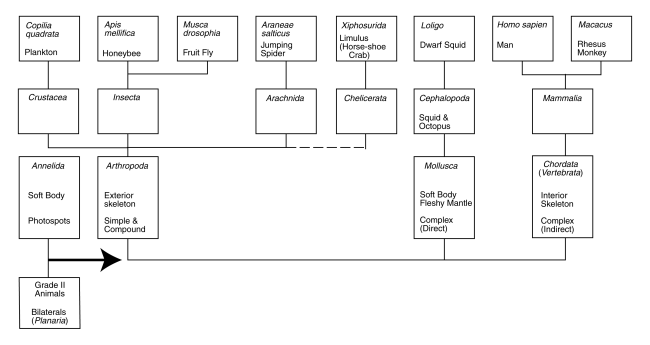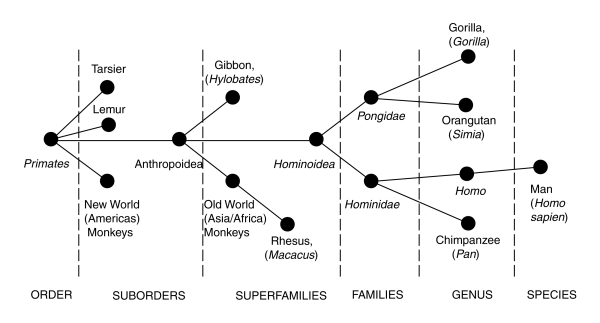
The following figure is presented here at reduced scale to accommodate a browser. A larger scale, more complete, version is available in Chapter 1 in the Download Files area reached from the Site navigation bar.

Phylogenic (aka phylogenetic) Tree of the Animal Visual System [from Section 1.2.1]
The more general term phylogenic is used here to stress ancestral relationships rather than the term phylogenetic that is coming to infer a more specific relationship based on either the genetic code or more in-depth comparative phylogeny.
The diagram shows a variety of species grouped according to the characteristics of their eyes. The terminal nodes in the top line represent currently extant species of specific interest when studying vision. Some exhibit unique evolutionary features. Only a few intermediate nodes are shown to help guide the reader. The material below the diagram documents the body type and eye type at the Phylum level. These features are discussed in Chapters 1 & 2.
In the development of this work, a number of visual capabilities have suggested a refinement of the phylogenic tree of the primates. The following figure highlights those features.

Phylogenic (aka phylogenetic) Tree of the Primates based on their Visual Systems [from Section 1.2.1]
Major features to note are three. The zoologist has a difficult time defining a specific ancestor at the points of division (nodes) along the median line. This leads to the median line nodes being described by a classification instead of an animal. Note the movement of the chimpanzee, Pan, into the family Hominidae because of its advanced thalamus. This feature accounts for its ability to most closely approach humans, Homo sapien, in visual tasks and learning. The evolutionary distance between the Old World Monkey Macacus and Homo sapien is critically important when attempting to use Macacus as a surrogate in high performance vision experiments. The development level of its thalamus leaves much to be desired.
Current research suggests the bifurcation of Hominoidea occurred about 6-7 million years ago. The bifurcation of Hominidae is believed to have occurred about 5-6 million years ago.
Return to the general Phylogenic Tree based on Vitamin A usage
Return to the website home page